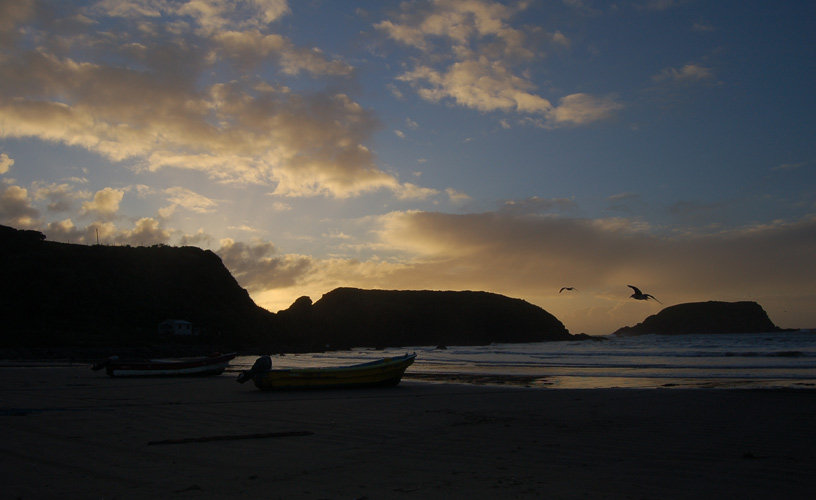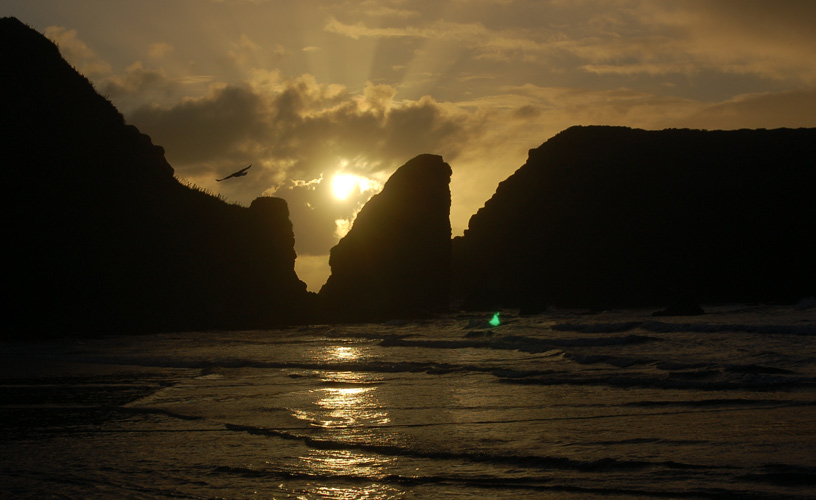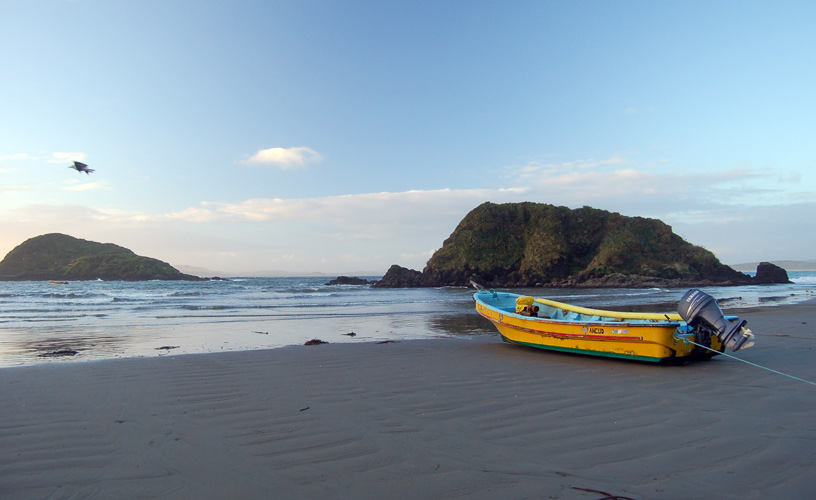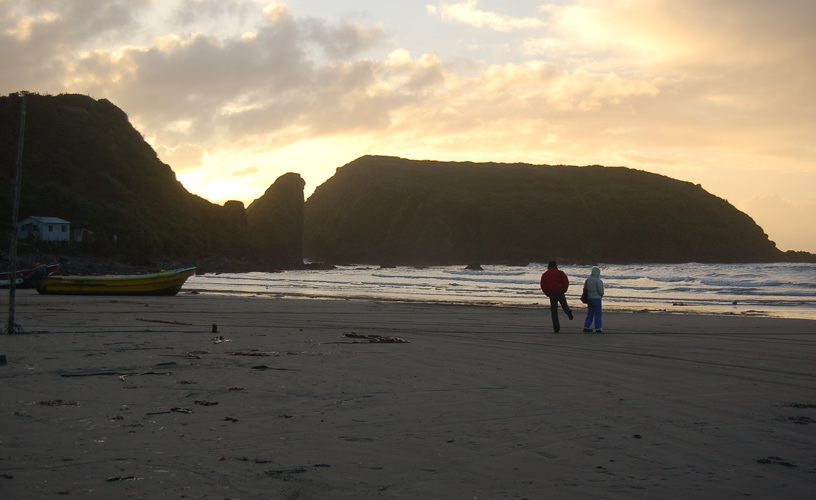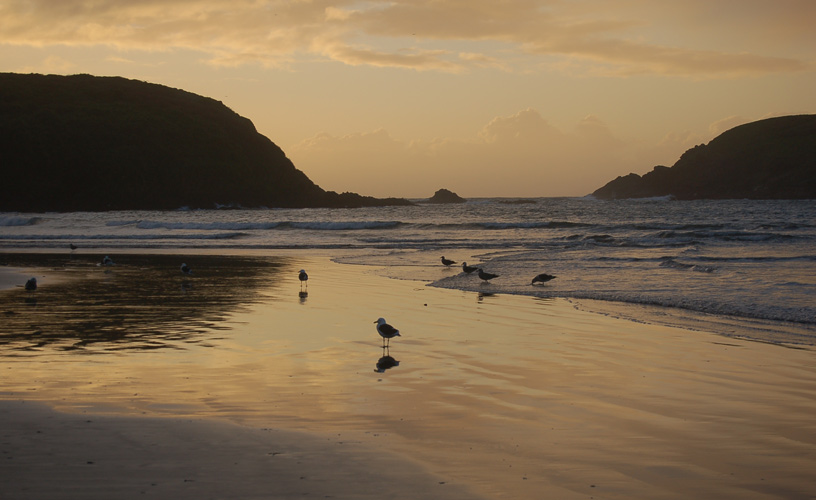The Untouched Islet
An untouched islet inhabited by hundreds of penguins and sea lions. A natural excursion, guided by experimented locals who live on fishing and tourism.
On our Way to a Strange Site, with a Stranger
Very much surprised, we listened to this man attentively, whose eyes were sparkling with joy as he told the experience. On the verge of being annoying, his words were tempting, and his insistence made us exchange looks and finally get on his truck. This man is a German who has lived in Santiago (Chile) for years. As he was driving, he told us the details of the excursion he had done the previous days. We were getting more and more eager to see that place so effusively described by the German. We headed for Quetalmahue first, and from there we took the road bordering the coast of the Pacific towards the South, till we reached the Mar Brava area (21 kilometers from Ancud). A beach with the same name lies there and gives evidence of the fury of the Pacific Ocean. On its Southern end is the Run Stone, natural testimony nestled amidst the vertiginous ravines. It owes its name to the noise produced by the southern wind and the sea waves when they bump against the huge stone. We got down nearby. The German acted as a host and introduced us to the locals. One of them was in charge of carrying out the excursion. We arranged the price and, without preamble, we set off.Heading for the Yearned Islet
We went along 4 more kilometers towards the South, to Puñihuil, where three islets lie in a beautiful bay very near the beach, lodging penguin colonies. From there, we got on the small wooden boat towards one of the major natural treasures in the community. The German, who was obviously on his back, with his daughters and a friend were traveling with us. The deep blue waters created a strange phenomenon described by the angler: when the Pacific Ocean mingles with the inner sea, waves are produced suddenly due to the difference of height between both, over 6 meters high. This phenomenon took place repeatedly and it was incredible to see how, right before our eyes, the sea suddenly rose and elevated us. The angler was a man of few words, but his experience at sea and his calmness gave us much trust. According to his words, Humboldt and Magellanic penguins would nest in those islets, co-existing in one same ecosystem, between December and March. These are two species that come from far away and struggle pacifically for survival in perfect harmony. And only one man lived on the islet we were going to visit: he was in charge of taking care of the place, and no one else could stay there. During the voyage, the German would promise that this time he would touch a penguin, as the previous time he had tried to do it but he had not been successful. Now he was obsessed with the idea. The angler smiled as he listened and then, in silence, he continued steering the boat with an admirable calmness. The voyage, which took about forty minutes, seemed to pass very fast. We were entering a small bay where the boat anchored, and we started to get off.Penguins
The German suddenly yelled: “There they are! Penguins!” He was the first one to go down; he was going mad about them. There were hundreds of penguins on the beach, at about 150 meters from us, with that tranquility which is characteristic of them when they are on solid ground. As we were getting off the boat with the shoes in our hands so that they would not get wet, the German started to run in order to touch them without any delay. Obviously, as he approached them, they would dive into the water. With the photo camera in my hand, I started to run on the rocks, barefoot (a sensation I recommend not to experiment), in order to take some pictures of them before they would all dive. As I ran and approached them, I could see them diving into the water. They seemed to be racing towards it. It was wonderful to see them diving and swimming at an amazing speed. Penguins can reach an approximate speed of 45 kilometers per hour inside the water. I was late: there were few penguins on land and the German had some marks from the pecks he had received. The other people arrived shortly afterwards. We stayed there watching them for a while, from a distance. But the excursion had not ended. The angler invited us to get on the boat once again, to take us down to meet other inhabitants of the islet: the sea lions.The Noisy Community
We started to border the islet and made out hundreds of sea lions resting on the large rocks. They shared that place with hundreds of seagulls, some standing on the stones and other flying around. As we continued to approach them, we heard the very loud and varied sounds made by the sea lions. A fascinating show no one should miss, especially when they start to dive into the water, one after the other, without stopping. They swam to come near the boat and watch us. Of course! What were we doing there? They were even more curious than we were. The angler turned off the engine and got us as near the rocks as he could. The sea lions continued diving and reaching closer and closer to the boat. It was amazing. We could not believe it, their heads would come off the water, one after the other… there were from 20 to 30 of them, very close, just two meters from us. Meanwhile, we continued listening to the funny noises made by the ones that remained on the rocks. Every now and then, the angler would turn on the engine and lead us far from the rocks, as the tide insisted on our getting close to them. All of us, just like little kids, would watch them and take pictures of them, with no wish to learn that we had to go back. We wanted that marvelous moment to last forever.Time to Go Back
But the moment to return to solid ground had arrived. We all said our good-byes, in our own way, to the penguins, the sea lions and the islet that had shown us so many wonders. The way back was quiet, each one remembering to ourselves what we had experienced, and carrying those unforgettable moments inside. The return would take longer, according to what the angler said, because of the tide. It had changed, and the sea was not so calm now as it had been in the morning, but nothing would tarnish our experience. To crown it all, once we were near the bay where we would disembark, the angler let us steer the boat for a while, as a strong wind would blow on our faces. Dusk was coming . * The Otway German Foundation has been working in a project to naturally protect and preserve penguin sites since 1997, not allowing disembarkation on the islets. Navigations guided by volunteers of the Foundation around the islets do take place. It is possible to navigate with traditional anglers who offer the tour at the Puñihuil and Quetalmahue settlements. Mónica Pons
Eduardo Epifanio
Leaving from Ancud along the waterfront, towards Lechagua (in the direction of the Pacific Ocean), after 14 km, take the road on the left towards Pumillahue and the Puñihuil beach. Before Pumillahue, you can take an irregular rubble and sandy road that leads to the Mar Brava beach (21 km from Ancud).
